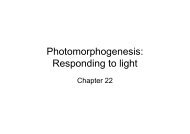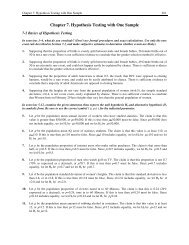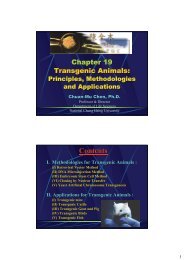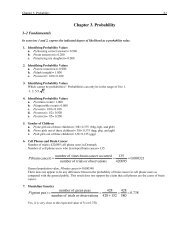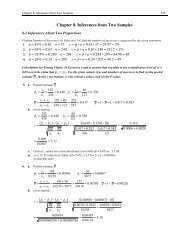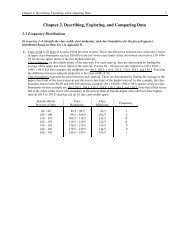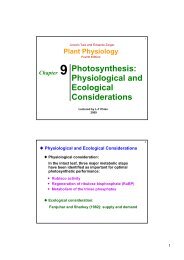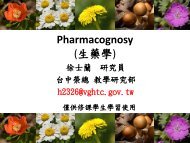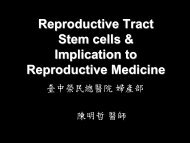isoform-like proteins in marine euryhaline milkfish (Chanos
isoform-like proteins in marine euryhaline milkfish (Chanos
isoform-like proteins in marine euryhaline milkfish (Chanos
You also want an ePaper? Increase the reach of your titles
YUMPU automatically turns print PDFs into web optimized ePapers that Google loves.
528C.-H. TANG ET AL.Fig. 6. The summary of Na 1 /K 1 -ATPase (NKA) a3-<strong>isoform</strong><strong>in</strong> gills of <strong>milkfish</strong> sampled at a series of different timesafter transfer from SW to HSW or FW. (A) Representativeimmunoblots of NKA a3-<strong>isoform</strong> probed with a polyclonalantibody revealed s<strong>in</strong>gle immunoreactive bands at approximately105 kDa. (B) The relative prote<strong>in</strong> abundance follow<strong>in</strong>gtransfer from SW to HSW <strong>in</strong>dicated that NKA a3-<strong>isoform</strong>decreased significantly after 12 hr post-transfer. On the otherhand, follow<strong>in</strong>g transfer from SW to FW, changes <strong>in</strong> therelative prote<strong>in</strong> abundance of NKA a3-<strong>isoform</strong> levels decl<strong>in</strong>edgradually dur<strong>in</strong>g 48 hr post-transfer and significantly decreasedat 96 and 168 hr post-transfer. Values were mean7SEM (n 5 6). The asterisks <strong>in</strong>dicated significant differences(Po0.05) compared with the 0 hr us<strong>in</strong>g Dunnett’s testfollow<strong>in</strong>g a one-way ANOVA. M, marker; SW, seawater;HSW, hypersal<strong>in</strong>e water.SW-acclimated <strong>milkfish</strong> (L<strong>in</strong> and Lee, 2005).Therefore, alteration of NKA activity <strong>in</strong> gills offish follow<strong>in</strong>g sal<strong>in</strong>ity changes may result fromdifferent NKA <strong>isoform</strong>s.There is accumulat<strong>in</strong>g evidence to presume thatNKA a-<strong>isoform</strong>s may change <strong>in</strong> teleosts to copewith the environmental fluctuations, e.g., sal<strong>in</strong>ityor temperature. The mRNA expression patterns ofgill NKA a1a and a1b exam<strong>in</strong>ed <strong>in</strong> varioussalmonid species were found to express differentially<strong>in</strong> FW- and SW-acclimated <strong>in</strong>dividuals(Richards et al., 2003; Bystriansky et al., 2006,2007a,b; Nilsen et al., 2007). Changes <strong>in</strong> mRNAexpression are often assumed to parallel changes <strong>in</strong>prote<strong>in</strong> abundance. The lack of correlationbetween mRNA and prote<strong>in</strong> of branchial NKAa-<strong>isoform</strong>s was reported (Morrison et al., 2006). Thislack of correlation between mRNA and <strong>prote<strong>in</strong>s</strong>uggested the correlation with posttranscriptionalregulation (Scott et al., 2004). This study,therefore, <strong>in</strong>vestigates the effect of environmentalsal<strong>in</strong>ity on the prote<strong>in</strong> expression of branchialNKA a-<strong>isoform</strong>s-<strong>like</strong> <strong>prote<strong>in</strong>s</strong> <strong>in</strong> <strong>milkfish</strong>.The am<strong>in</strong>o acid identities of <strong>in</strong>dividual <strong>isoform</strong>sacross species are higher than the identities ofdifferent <strong>isoform</strong>s with<strong>in</strong> one species (Blanco andMercer, 1998). Therefore, the heterologous antibodiesto NKA a-<strong>isoform</strong>s (polyclonal antibodiesdirected aga<strong>in</strong>st the rat a-specific <strong>isoform</strong>s) wereused <strong>in</strong> Atlantic salmon (Salmo salar) (D’Cottaet al., 2000) as well as <strong>in</strong> this study. Among the<strong>isoform</strong>-specific heterologous antibodies used <strong>in</strong><strong>milkfish</strong>, mouse monoclonal antibody a6F to theavian NKA a1-<strong>isoform</strong> and goat polyclonal antibodysc-16052 to human NKA a3-<strong>isoform</strong> had beenapplied <strong>in</strong> teleosts previously (tilapia, Oreochromismossambicus; Lee et al., 1998; Antarctic fish,Trematomus bernacchii; Brauer et al., 2005). Thisstudy identified three NKA a-<strong>isoform</strong>-<strong>like</strong> <strong>prote<strong>in</strong>s</strong><strong>in</strong> <strong>milkfish</strong> gills with these <strong>isoform</strong>-specific antibodiesby immunoblott<strong>in</strong>g analysis (Figs. 1A, 2A,and 3A). Three NKA a-<strong>isoform</strong>-<strong>like</strong> <strong>prote<strong>in</strong>s</strong> werealso found <strong>in</strong> the gills of Antarctic fish (Guynnet al., 2002), while only a1 anda3 werereported<strong>in</strong>tilapia gills (Lee et al., 1998; Feng et al., 2002). Theimmunoblots of <strong>milkfish</strong> gill lysates probed witheach <strong>isoform</strong>-specific antibody revealed s<strong>in</strong>gle immunoreactivebands at approximately 105–115 kDa(Figs. 1A, 2A, and 3A), similar to those recognized<strong>in</strong> tilapia (Lee et al., 1998) and Antarctic fish(Guynn et al., 2002; Brauer et al., 2005).This study revealed that the SW-acclimatedgroup was significantly higher than the FW- orHSW-acclimated groups <strong>in</strong> the levels of NKAa1- and a3-<strong>like</strong> <strong>prote<strong>in</strong>s</strong> (Figs. 1 and 3). Expressionpattern of NKA a2-<strong>like</strong> prote<strong>in</strong> <strong>in</strong> the gills were notsal<strong>in</strong>ity-dependent (Fig. 2B). It was suggested thata1- and a3-<strong>like</strong> <strong>prote<strong>in</strong>s</strong> might play the role forosmo- or ionoregulation but a2-<strong>like</strong> prote<strong>in</strong> probablyperformed the other physiological function.The aff<strong>in</strong>ity of gill NKA for sodium <strong>in</strong>creasedsignificantly <strong>in</strong> warm-acclimated Antarctic teleost(T. bernacchii; Morrison et al., 2006) that isopposite to <strong>milkfish</strong>, which has lower sodiumaff<strong>in</strong>ity <strong>in</strong> SW than FW (L<strong>in</strong> and Lee, 2005).Upregulation of gill a1- and a2-<strong>like</strong> <strong>prote<strong>in</strong>s</strong><strong>in</strong>fluenced sodium aff<strong>in</strong>ities and fulfilled some ofthe requirements for the subtly moderated enzymebehaviors (e.g., elevated NKA activity) <strong>in</strong> warmacclimatedT. bernacchii (Morrison et al., 2006),while the changes <strong>in</strong> gill NKA a1- and a3-<strong>like</strong><strong>prote<strong>in</strong>s</strong> may play the potential role for reductionof sodium aff<strong>in</strong>ities to decrease NKA activity <strong>in</strong>SW-exposed <strong>milkfish</strong>. In addition, the role of NKAJ. Exp. Zool.




